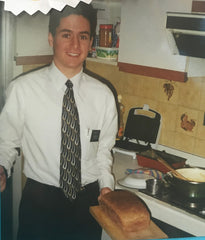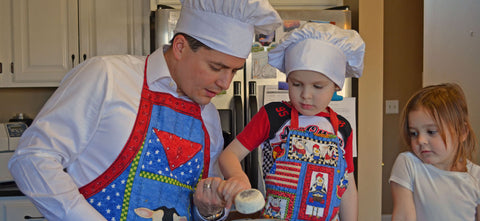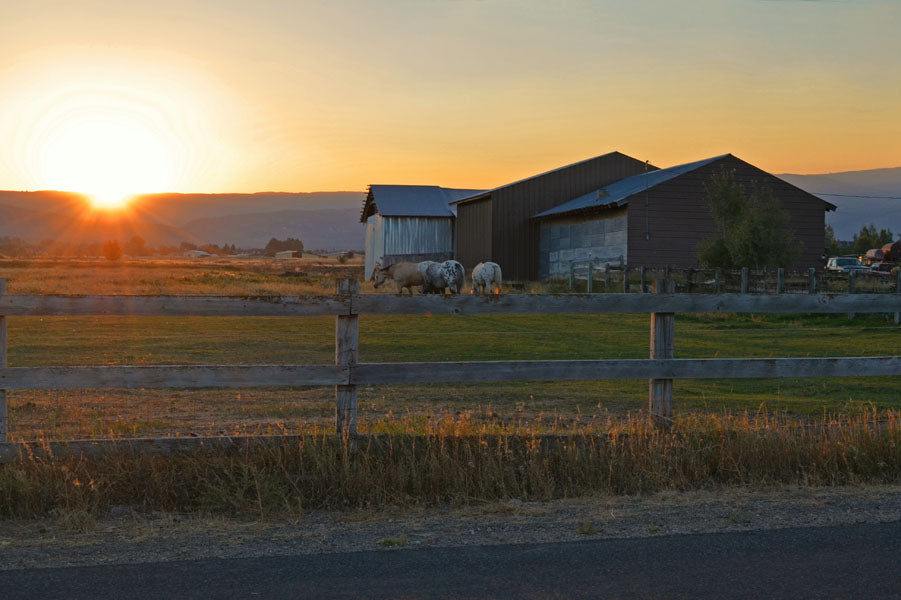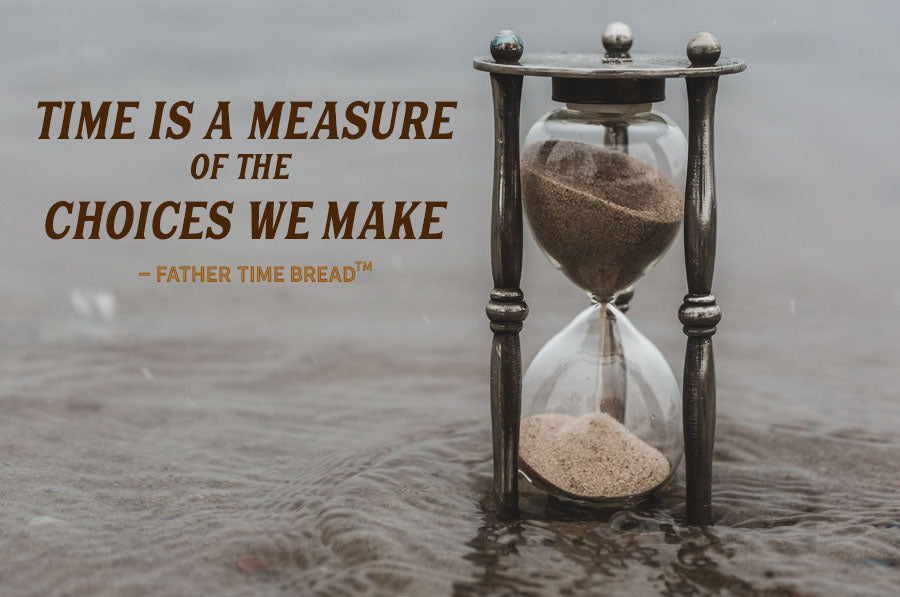
Call it a love affair with bread. We love bread in our family. Good bread, that is. And we love sharing it. That’s why we’ve spent over 20 years in our home perfecting the art of homemade, whole grain bread that tastes amazing. And the more we learned about how food is made in America, we grew determined to help things change for the better. So we started Father Time Bread.
That’s the short story. Here’s the rest of the story:

 When I lived in Spain for a couple years doing missionary work, one element of their lifestyle stood out to me as something America should have adopted generations ago. They eat good bread. Fresh bread. Not the kind of bread that sits around in warehouses and grocery store shelves for weeks before its eaten. They buy fresh bread daily, and enjoy it because it tastes good. Fresh bread usually does.
When I lived in Spain for a couple years doing missionary work, one element of their lifestyle stood out to me as something America should have adopted generations ago. They eat good bread. Fresh bread. Not the kind of bread that sits around in warehouses and grocery store shelves for weeks before its eaten. They buy fresh bread daily, and enjoy it because it tastes good. Fresh bread usually does.
 Since I didn’t have much money in Spain, I decided to start baking my own bread. My mother began experimenting with homemade bread when I was a teenager, so I asked her for a few tips. I bought some whole wheat from the farmer’s market in Orense, Spain and purchased a block of yeast from a local bakery. My methods and ratios were rather raw and unrefined, but eventually the bread started to turn out fairly well. The creative bread process began, and it was a curiosity that I could hardly put down. I often wondered: could I possibly figure out a way to someday change or even revolutionize how America eats bread? A boy can dream.
Since I didn’t have much money in Spain, I decided to start baking my own bread. My mother began experimenting with homemade bread when I was a teenager, so I asked her for a few tips. I bought some whole wheat from the farmer’s market in Orense, Spain and purchased a block of yeast from a local bakery. My methods and ratios were rather raw and unrefined, but eventually the bread started to turn out fairly well. The creative bread process began, and it was a curiosity that I could hardly put down. I often wondered: could I possibly figure out a way to someday change or even revolutionize how America eats bread? A boy can dream.
 When I came back to America and finished college I dove back into my bread hobby. I purchased bread-making equipment, accumulated a baking cookbook collection, closely studied a premium whole grain bakery chain, baked nearly every day, and shared my bread with friends for feedback and ideas.
When I came back to America and finished college I dove back into my bread hobby. I purchased bread-making equipment, accumulated a baking cookbook collection, closely studied a premium whole grain bakery chain, baked nearly every day, and shared my bread with friends for feedback and ideas.
 A few years after college I married the sweetest girl in the world, Kara, and fortunately she loved bread almost as much as I did. We began grinding our own wheat and heavily experimenting with our own recipes. From the beginning I’ve been fixated on maximizing both taste and nutrition – at the same time – and figuring out what variables I could adjust to make that happen. Finding the right source of whole wheat, buying the right wheat grinder, switching from sugar to honey, simplifying the ingredients, and many other keys fell into place and we began to make amazing bread. At least we thought so.
A few years after college I married the sweetest girl in the world, Kara, and fortunately she loved bread almost as much as I did. We began grinding our own wheat and heavily experimenting with our own recipes. From the beginning I’ve been fixated on maximizing both taste and nutrition – at the same time – and figuring out what variables I could adjust to make that happen. Finding the right source of whole wheat, buying the right wheat grinder, switching from sugar to honey, simplifying the ingredients, and many other keys fell into place and we began to make amazing bread. At least we thought so.
 I loved food so much that after graduate school I started working for one of the largest and most respected food companies in America: General Mills in Minneapolis. After a few months working there I brought a loaf of my homemade bread to share with co-workers, and it was quickly devoured. One of my co-workers, Laura, asked me to sell her a loaf. Initially I thought she was either half-joking or just being polite, but when she reiterated and reminded me of her request I could tell she was serious. So, I sold her a loaf. Then another, and another. It was fun to bring in a homemade creation that people really seemed to enjoy, and several other co-workers quickly asked to buy the bread. One even began buying four loaves a week for her household and did so for the next three years.
I loved food so much that after graduate school I started working for one of the largest and most respected food companies in America: General Mills in Minneapolis. After a few months working there I brought a loaf of my homemade bread to share with co-workers, and it was quickly devoured. One of my co-workers, Laura, asked me to sell her a loaf. Initially I thought she was either half-joking or just being polite, but when she reiterated and reminded me of her request I could tell she was serious. So, I sold her a loaf. Then another, and another. It was fun to bring in a homemade creation that people really seemed to enjoy, and several other co-workers quickly asked to buy the bread. One even began buying four loaves a week for her household and did so for the next three years.
 I called it Taylor Made Bread and printed labels with nutrition facts that I calculated using software at home. I developed a variety of flavors: Honey Whole Wheat, Cinnamon Wheat Swirl, Garlic Parmesan Herb, and Pumpkin Spice. I bought professional bread bags and twist ties, and it became really fun. Over 100 of my co-workers either bought my bread at one point or were regular customers. The only problem was there was too much demand, and I couldn’t make enough. I was already waking up at 5:00am each morning to bake four loaves of bread each day in my townhouse kitchen, and had sold over 1,000 loaves in the course of three years. When our third baby was born, and our household switched from man-to-man to zone defense (you parents know what I mean), I knew that I couldn’t sustain this pace. I had to take a break, so I notified all of my friends buying bread that Taylor Made Bread was currently on hold, but that someday I hoped to figure out a way to scale it up for real. But could I really?
I called it Taylor Made Bread and printed labels with nutrition facts that I calculated using software at home. I developed a variety of flavors: Honey Whole Wheat, Cinnamon Wheat Swirl, Garlic Parmesan Herb, and Pumpkin Spice. I bought professional bread bags and twist ties, and it became really fun. Over 100 of my co-workers either bought my bread at one point or were regular customers. The only problem was there was too much demand, and I couldn’t make enough. I was already waking up at 5:00am each morning to bake four loaves of bread each day in my townhouse kitchen, and had sold over 1,000 loaves in the course of three years. When our third baby was born, and our household switched from man-to-man to zone defense (you parents know what I mean), I knew that I couldn’t sustain this pace. I had to take a break, so I notified all of my friends buying bread that Taylor Made Bread was currently on hold, but that someday I hoped to figure out a way to scale it up for real. But could I really?
 For the next several years I didn’t sell any bread but kept baking it, eating it, and sharing it. My kids were absolutely hooked. For a few years it was one of the ten foods that my oldest son would voluntarily put in his mouth. And he loved it with a passion. He still starts almost every day with a couple slices of fresh cinnamon toast. Our fourth child relied heavily on our bread as one of his favorite baby finger foods. There is something special about this bread: crave-ably delicious and yet wholesome at the same time; filling and nourishing, but not bloating. Eating it feels good to the mouth, the tummy, and the soul. We knew we had something special.
For the next several years I didn’t sell any bread but kept baking it, eating it, and sharing it. My kids were absolutely hooked. For a few years it was one of the ten foods that my oldest son would voluntarily put in his mouth. And he loved it with a passion. He still starts almost every day with a couple slices of fresh cinnamon toast. Our fourth child relied heavily on our bread as one of his favorite baby finger foods. There is something special about this bread: crave-ably delicious and yet wholesome at the same time; filling and nourishing, but not bloating. Eating it feels good to the mouth, the tummy, and the soul. We knew we had something special.
 Meanwhile, my food career and our family food philosophy were undergoing a major transition. Kara and I both read Michael Pollan’s seminal book The Omnivore’s Dilemma, among many others of its kind, and felt a gradually broadening awareness for how food in America is made. Our choices changed toward more homemade, less processed, and higher quality foods. I initially thought that my personal food choices weren’t scalable to mainstream America because the present state of industrialized food, in which I worked as a business leader, provided an efficient delivery of economical food options for the masses. Then everything changed.
Meanwhile, my food career and our family food philosophy were undergoing a major transition. Kara and I both read Michael Pollan’s seminal book The Omnivore’s Dilemma, among many others of its kind, and felt a gradually broadening awareness for how food in America is made. Our choices changed toward more homemade, less processed, and higher quality foods. I initially thought that my personal food choices weren’t scalable to mainstream America because the present state of industrialized food, in which I worked as a business leader, provided an efficient delivery of economical food options for the masses. Then everything changed.
 I received a new work assignment within the Small Planet Foods natural and organic division at General Mills to manage the Cascadian Farm Organic and Muir Glen Organic brands. I was ecstatic. These were two premium brands whose quality, purpose, and food ideals seemed to match my own passion for quality food. Little did I know that they would heavily evolve and advance my understanding of the future of food.
I received a new work assignment within the Small Planet Foods natural and organic division at General Mills to manage the Cascadian Farm Organic and Muir Glen Organic brands. I was ecstatic. These were two premium brands whose quality, purpose, and food ideals seemed to match my own passion for quality food. Little did I know that they would heavily evolve and advance my understanding of the future of food.
 Organic food was far different than I ever imagined. In my youth I had thought of “organic” as a gimmicky marketing tactic to charge a premium for hippy-grown food. Now I finally started to realize that these hippies were on to something: soil health, pollinator preservation, crop rotation, cover crops, compost, avoiding harsh chemicals, relying on nature as an ally rather than an adversary, and much more. Kara and I began to understand how the core tenets and strict requirements of organic methods are far more wholesome, holistic, rational, pure, and long-term focused than the cheaper, chemical-laden, shorter-term strategies and shortcuts of heavily industrialized food companies. And while we realized that organic doesn’t equal perfection and is not the only moniker of quality, Kara and I knew one thing was for sure: we were organic converts.
Organic food was far different than I ever imagined. In my youth I had thought of “organic” as a gimmicky marketing tactic to charge a premium for hippy-grown food. Now I finally started to realize that these hippies were on to something: soil health, pollinator preservation, crop rotation, cover crops, compost, avoiding harsh chemicals, relying on nature as an ally rather than an adversary, and much more. Kara and I began to understand how the core tenets and strict requirements of organic methods are far more wholesome, holistic, rational, pure, and long-term focused than the cheaper, chemical-laden, shorter-term strategies and shortcuts of heavily industrialized food companies. And while we realized that organic doesn’t equal perfection and is not the only moniker of quality, Kara and I knew one thing was for sure: we were organic converts.
Another major epiphany Kara and I had while I worked on organic brands was the growing swell of demand for organic and higher quality natural foods across the country. Brands like Clif, Kind, Chobani, Nature’s Path, Annie’s, and many more began to show such strong growth that they were changing the food industry in a very big way as families like ours voted with their wallets. While I loved working at General Mills, which had an amazing culture, I realized that my heart and passion for premium, natural foods would thrive far more at a smaller company dedicated to natural foods. And we wondered: could we ever start our own company?
 One day as Kara and I reflected on all of the exciting changes in the food industry we realized that our beloved bread category was still largely untouched by creative innovation, despite all of the other quality advances across other food categories. But how could we capture the freshness of our homemade bread in a distribution system where grocery bread loaves often sit in warehouses and on store shelves for weeks before being eaten, compelling companies to use cheaper ingredients, chemical preservatives, and other objectionable additives? That violated everything we believed in and would compromise the quality that we worked so hard to achieve with our unique homemade recipe. What we needed was a breakthrough. Luckily for me, I married well.
One day as Kara and I reflected on all of the exciting changes in the food industry we realized that our beloved bread category was still largely untouched by creative innovation, despite all of the other quality advances across other food categories. But how could we capture the freshness of our homemade bread in a distribution system where grocery bread loaves often sit in warehouses and on store shelves for weeks before being eaten, compelling companies to use cheaper ingredients, chemical preservatives, and other objectionable additives? That violated everything we believed in and would compromise the quality that we worked so hard to achieve with our unique homemade recipe. What we needed was a breakthrough. Luckily for me, I married well.
 Kara had a stroke of genius. She wondered out loud if we might freshly bake our bread and then immediately ship it directly to families in a direct-to-consumer model rather than through grocery stores. The more I thought about it the more I realized how clever her idea was. Shipping is now so fast and efficient in America that we could deliver bread directly to families far faster than a grocery bread brand. And the cost of our super-premium bread with its unique and very expensive recipe could also be alleviated by cutting out the grocery store middleman and making the bread more accessible to busy families.
Kara had a stroke of genius. She wondered out loud if we might freshly bake our bread and then immediately ship it directly to families in a direct-to-consumer model rather than through grocery stores. The more I thought about it the more I realized how clever her idea was. Shipping is now so fast and efficient in America that we could deliver bread directly to families far faster than a grocery bread brand. And the cost of our super-premium bread with its unique and very expensive recipe could also be alleviated by cutting out the grocery store middleman and making the bread more accessible to busy families.
After that inspired conversation, we kicked off this project which became Father Time Bread. We initially found a bakery where we could use some of their extra space to to bake and ship our fresh bread. It went phenomenally well, and in just a few short months we shipped fresh bread to customers in 29 different states.
As we grew, the bakery partner we were working with no longer had that extra space we were using, and we couldn't find another bakery nearby that met our needs and strict organic specifications. So, we decided to change things up.
After all, the bread we have enjoyed over the years is bread baked in our own oven. Couldn't we replicate that for other families in their home oven? Sure, baking is no walk in the park, but surely we could simplify the process and educate people on how to easily make amazing bread in their home. And that is exactly what's coming next - just wait and you'll see...
Our vision is for Father Time to help families easily make bread and other family-favorite food staples where homemade quality beats packages from a store. In our busy family with four children we know how helpful it is to find and rely on wholesome, delicious foods that our kids will actually eat. It sure makes packing lunches, preparing snacks, and serving meals a lot better family experience…
 This is a passion project for our family to share a product and a cause that we deeply believe in. By providing a simple and convenient way to bring more wholesome food to the table, we hope to help families spend their precious time eating better and playing more.
This is a passion project for our family to share a product and a cause that we deeply believe in. By providing a simple and convenient way to bring more wholesome food to the table, we hope to help families spend their precious time eating better and playing more.
We are Kara and Taylor West, parents of four children, living in a lovely Rocky Mountain valley in Heber City, Utah. We hope you’ll join us together in this journey to make our food more wholesome and keep our families more together.


